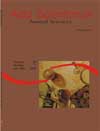Rendimento do processamento da tilápia-do-nilo (Oreochromis niloticus): tipos de corte da cabeça em duas categorias de peso
Resumo
O objetivo do presente estudo foi avaliar o melhor tipo de corte de cabeça para decapitação da tilápia-do-nilo (Oreochromis niloticus), que resulte em melhores rendimentos de filetagem. O experimento foi conduzido na Estação de Piscicultura da UEM/Codapar, Maringá, PR. Foram abatidos 120 exemplares cortadas as cabeças, eviscerados, removidas as nadadeiras, pele e filés. O processo de filetagem foi realizado por uma única pessoa. O delineamento foi inteiramente casualizado, em esquema fatorial 2x3. Os tratamentos foram: duas categorias de peso (P1= 250-400 g e P2= 401-550 g) e três tipos de corte de cabeça (C1=oblíquo, OB; C2=contornado, CO e C3=reto, RE), com 20 repetições. Cada peixe foi considerado a unidade experimental. Os valores médios de rendimento foram expressos em relação ao peso corporal do peixe. Houve influência do tipo de corte e categoria de peso sobre o rendimento do tronco limpo e filé. Os rendimentos em P2 (OB=50,42%, 35,27%; CO=50,70%, 35,18% e RE=48,50%, 33,82%) foram superiores (p < 0,05) aos de P1 (OB=47,35%, 32,64%; CO=47,65%, 31,86% e RE=40,79, 27,72%) para tronco e filé, respectivamente. Dentro da menor categoria de peso (P1), os rendimentos de tronco e filé foram influenciados (p < 0,05) pelo tipo de corte da cabeça, em que RE apresentou menor rendimento comparado ao OB e CO. Os rendimentos de carcaça sem cabeça (61,91%), músculo abdominal ventral (2,85%), músculo hipaxial profundo (4,72%) em P2 foram superiores (p < 0,05) aos de P1 (57,13%; 2,45% e 3,75%), respectivamente para as características analisadas. Além disso, a categoria de peso não influenciou a percentagem de pele e outros resíduos, exceto a da cabeça (p < 0,01). Para percentagem de cabeça o P1 foi significativamente superior (30,67%) e inferior para P2 (27,07%). Por outro lado, o rendimento e percentagem de subprodutos foram influenciados (p < 0,05) pelo tipo de corte de cabeça, com CO mostrando melhores rendimentos para carcaça sem cabeça (62,47%) e músculo abdominal ventral (4,33%) e porcentagem de pele (5,99%); e menores percentagens de cabeça (24,79%) em comparação ao OB e RE. Não houve influência do corte no músculo hipaxial profundo (OB=4,01%, CO=4,36% e RE=4,03%). Os resultados sugerem que, nestas condições de filetagem, os peixes acima de 400 g de peso corporal são os mais indicados para serem abatidos, utilizando-se o corte contornado e oblíquo para obtenção dos melhores rendimentos de filé e tronco limpo para tilápia.Downloads
DECLARAÇÃO DE ORIGINALIDADE E DIREITOS AUTORAIS
Declaro que o presente artigo é original, não tendo sido submetido à publicação em qualquer outro periódico nacional ou internacional, quer seja em parte ou em sua totalidade.
Os direitos autorais pertencem exclusivamente aos autores. Os direitos de licenciamento utilizados pelo periódico é a licença Creative Commons Attribution 4.0 (CC BY 4.0): são permitidos o compartilhamento (cópia e distribuição do material em qualqer meio ou formato) e adaptação (remix, transformação e criação de material a partir do conteúdo assim licenciado para quaisquer fins, inclusive comerciais.
Recomenda-se a leitura desse link para maiores informações sobre o tema: fornecimento de créditos e referências de forma correta, entre outros detalhes cruciais para uso adequado do material licenciado.








































